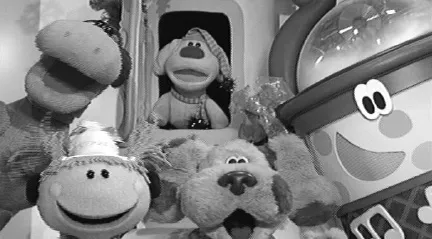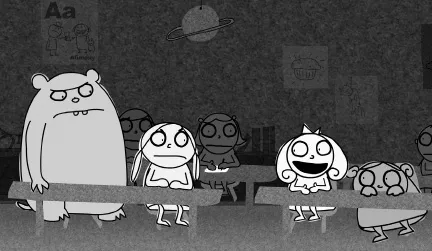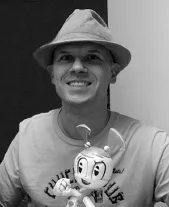![]()
CHAPTER 1
ANATOMY OF AN ANIMATION DIRECTOR
As the director, your goal is to get your vision up onto the screen, and you can’t do that if your team isn’t behind you. And keep in mind that everyone you work with will need something different from you: Some animators will need very specific timings and direction, and others will knock a scene out of the park with only a list of a few important story points to guide them. The most successful directors, I think, are the ones who can quickly and accurately figure out each teammate’s working style and can adapt to those styles when it would help the team create the best possible animation in the least amount of time.
—David J. Palmer, TV series animation director
A still from Nick Jr.’s Blue’s Room, from an episode directed by five-time Emmy-nominated Koyalee Chanda, who started directing TV at the age of 23. Copyright 2010. Viacom International Inc. All rights reserved.†
An animation director has a very rewarding position with duties that may include shaping the production pipeline, creating the schedule, staffing the production, and managing the workflow while maintaining the crew’s morale. All this is in addition to the main responsibility of creatively directing the entire process of a production, from storyboards to final delivery of animation. Whew!
As an animation director, I’ve made just about every mistake possible and, perhaps, have even invented some new ones. A key theme of this book is animation directors don’t direct animation, they direct people who animate frame-by-frame using pixels, pencils, clay, paper cutouts, cigarette butts, etc. Therefore you might conclude that a director’s ability to work effectively as a crew leader, inspiring and enabling a team to deliver their very best, would be instrumental to their success.
The best directing leadership lesson I ever learned was from a live- action director! The director was Rick Fernandes, and I was privileged to work with him during the live-action shoot for several episodes of Blue’s Room. As the series animation director, I had to be present for the whole shoot to make sure all animation’s needs for post would be met. Much of the footage we were shooting of puppets/actors (some against practical sets and some against green screen) would later feature an animated element, effect, or character added in by my team of animators.
In addition to Rick, there were at least four other live-action directors that season, each of them capable and skilled in their own right. When Rick stepped up to direct his first scene, however, I noticed something different. All the other directors had directed from behind the barrier of a director’s station. This seven-foot-high station was equipped with monitors, clipboards, water, paperclips, etc. From this vantage point, directors couldn’t make eye contact with the puppeteers, camera people, or stage crew during a take. Before each new setup was shot, the other directors would summarize their plan to the puppeteers and then step back, directing from behind their station as the shot was recorded to tape.
The director’s station was near the back table where the executive producers and network executives sat. Most often, even after one take on a setup, the executive producers would call the directors over and start giving them notes. These might be notes on puppeteer acting, scene blocking, technical issues, and so on, all from just the one take. Often, these directors, after one take, might even seek out these notes. With this directing style, shots took many takes before we were able to move on, sometimes leading to overtime situations. Don’t forget that a puppeteer spends much of their day hunched over with one arm outstretched high and crowned with a heavy puppet (ah, the glamorous life of a puppeteer). A normal day is taxing, so a long day can be particularly grueling on a puppeteer’s stamina.
Like the other directors, Rick worked out a scene with the crew and puppeteers before trying a take. The difference was that once the camera started to roll, Rick didn’t retreat behind the director’s station. Instead he stayed with the puppeteers. With one eye on the puppeteer floor monitors to see what the camera was shooting, and one eye on the actual performers and space, Rick put himself where the action was. He saw what the puppeteers were dealing with. If one of them had difficulty getting around a piece of the set, he noticed it instead of wasting takes from behind the director’s station before realizing it. Rick was there for the actors and the crew. He was one of them. And, his method ensured that he—and the show—got what was needed.
There was another element to Rick’s technique or style that really impressed me. Because he wasn’t directing from behind a station so close to the producer table, Rick gave himself more room to create and solve problems without needing to have everything spoon-fed to him or weighed in on by the execs. I heard Rick explain his process to the producers just before shooting his first episode: “Let me have two takes to try to work things through. If you still have notes after that, we can go over them.” I sat close to the producer table and, as Rick set up his first shot, the producers murmured concerns to each other about the lighting, acting, scene blocking, and so on—all stuff that Rick, too, was seeing and adjusting for over his two takes. Often, by the end of the second take, the shot was in the can and we were able to move on to a new set up. To his credit, Rick always checked with the producers to make sure they got what they needed, and he was always open to any further feedback they might offer.
This experience stayed with me and improved my skills as a director: I try to keep close by my animators and make sure their needs are met and any obstacles removed so they may do their best work. There are animation directors who like to close themselves off behind an office door during a production. Some young animators I know are working on a series and they recently told me that they didn’t even know their director’s name because, even after several months, they had still never met him! This is sad stuff on a human level and obviously bad for the process and the product.
The Closed-Door Director
According to Nickelodeon’s Making Fiends creator and director Amy Winfrey, one advantage to having in-house animators is that the director can talk directly to the animator. “It is much easier to get exactly what you want from a shot if you are able to communicate directly with the animators,” she says. That may seem like common sense, but there are plenty of stories of animation directors squandering the opportunity to collaborate with an in-house crew. In contrast, Winfrey works closely with her entire staff, encouraging the storyboard artists and animatic editors to suggest changes and gags, which can make the finished episode much stronger. The animation director of an in-house production has the chance to bring the whole crew together. On Making Fiends, Winfrey says, “We always showed the first pass of the animatic to the whole crew. It was wonderful to see the work of the writers, storyboard artists, and voice actors come together. It’s always satisfying to hear people laugh!”
A still from Amy Winfrey’s Nickelodeon series, Making Fiends. Copyright 2010. Viacom International Inc. All rights reserved.†
If Winfrey and Fernandes provide best-case scenarios, a recent job animating on a pilot provided my worst experience to date. And in the same way that it’s useful to examine what makes good direction so effective and inspiring, analyzing the opposite extreme can help bring into focus the pitfalls of directing and how they can be avoided. In all fairness, sometimes great facility as an artist or animator can be why a person gained the opportunity to direct. But talent in one area does not automatically translate to another. Having the skills to manage, lead, inspire, and direct others is quite different.
The average animation artist wears many hats over a typical career, and for those who direct, it’s helpful to have been directed. This will give important insight into the process of how work is assigned/reviewed, how notes are given, how workflow/deadlines are managed, and how it feels to be directed. Remember what you liked and didn’t like when you were directed. What style of organization made things run smoothly and what caused problems? As a director you’ll have a lot of influence you can use to create a winning production pipeline or help fine-tune an existing system that could run even better.
Once you have worked as a director you will still likely work again in other areas on subsequent jobs, maybe as a storyboard artist, animator, or designer. After working exclusively as a director for eight years in a row, I found myself working as an animator on a preschool pilot. Right away we animators knew the project was going to be challenging. First of all, many scenes were up to twenty seconds long and usually featured four characters that we had to keep alive and interacting. The pilot’s character files, animated in After Effects, were cumbersome, overly complex, and constantly crashing the computer, which slowed down workflow. Full character rotations were built for each character when a half rotation would have sufficed and been a lot more efficient. All of this was because of the director’s desire to use “full animation” in a tight TV animation budget and schedule. After Effects can certainly work wonders to help shave off some work hours, but it can’t work miracles. The miracle was expected to come from the animators.
Added to this was a director who sequestered herself in her closed-door office, not fully committing to her responsibilities on this pilot. Since the in-house crew of animators didn’t have access to her, she insisted we all log on to Instant Messenger so she could answer any questions or send us direction. It was a very sad waste of our proximity. In fact, the only time I would see her at my desk was when an artist from another production would (briefly) stop by to say hello to me, which would cause my director to suddenly appear to shoo the visitor away. Ah, there’s nothing like working in a trusting environment—and this was nothing like working in one. Outside of those times, the director remained mostly shuttered away, on the phone, and unavailable.
Rob Renzetti, Animation director and creator of Jenny (XJ-9), the star of his series My Life as a Teenage Robot (Frederator/Nickeldeon). Photo courtesy of the artist.
Robert Renzetti, veteran animation director and creator of Nickelodeon/ Frederator’s My Life as a Teenage Robot, explains that if you are strictly doing timing (on exposure sheets), you can hide in your room all day if you like and talk to no one. But, he warns, “This would not bode well for your future employment. The more you are involved with other aspects of the production process the more people skills you will need.” And to that I would add, the more direct contact with people you should have.
The first thing I noticed when I started on this job was that all the scene numbers and tracking numbers of all art and assets didn’t match to the storyboard/animatic numbers. So, when you got a scene assignment, you weren’t sure which was the correct scene to animate. As we worked we found that we couldn’t rely on the storyboard/animatic as the final word for scene cuts or blocking. The creators, producers, and directors kept changing their minds.
For the first month, no deadline targets were assigned for any scene. The production was that loose! Finally, once it became clear that thepilot was going to go over schedule, the senior staff had a meeting and decided to implement a daily footage quota on the animators. From this point forward, each animator was expected to deliver a minimum of eight seconds of finished animation per day. This wasn’t so impossible, unless you factored in that each scene likely held four characters. This could significantly impact the ability to deliver eight seconds a day because four characters could mean four times as much work. But, since the director and the production didn’t acknowledge the reality in their quota, it was a real morale-killer.
As the pilot neared completion, the strain on the budget increased and we went weeks over schedule. The director showed signs of stress that came out as she unprofessionally griped about the work of one animator to another. I’ll never forget one particular day on the pilot when I was animating a four-character scene that was eighteen seconds long. At the end of the day I had two of the characters fully animated all the way up to eighteen seconds. I put on my coat to call it a night, but the director stopped me before I could leave.
“Did you finish your scene?” she asked. “No,” I answered. “I just started this one today . . . but I did get two of the characters animated all the way through.” She replied, “So, it’s not finished? You’re going to deliver the shot late?” “What is late?” I asked. “I animated two characters all the way through to 18 seconds. Based on the eight-seconds-a day-quota, I more than doubled the expectation. So it was a good work day with a lot accomplished.”
“Well, it would have been great if it could have been done today,” she insisted. Realizing I was talking to a wall, I smiled and shrugged my shoulders. Then she shrugged her shoulders back to me and concluded with, “I’m just saying.”
I truly have had a charmed work life, because this two-month job was the worst working experience of my thirteen-year career. It also demonstrates the importance of a strong director who understands every aspect of the job. Earlier, I stressed that it’s important for a director to have worked in other animation positions prior to directing. This director met those requirements, having worked for years in the industry in various capacities, and was a talented and accomplished artist to boot. The problem was she didn’t utilize her knowledge of process, schedule, deadlines, and what it feels like to be directed to help build a workable production. A key to learning or self-development is the ability to have some degree of introspection. You have to be able to take responsibility for mistakes, to recognize your role in the problem, and to have the desire to not make those mistakes again.
The pilot (in this story) finally got finished and, due to the considerable extra time we spent (and despite the toll on the crew), it looked good. As for the director, the ball is in her court, and she may have learned about working with a staff of in-house animators and crew and what it takes to properly prep, assign, schedule, and direct their work. Animation director Rob Renzetti knows the benefits of working with an in-house crew based on his experience on Cartoon Network’s Foster’s Home for Imaginary Friends, saying, “Almost a...





